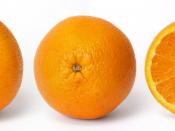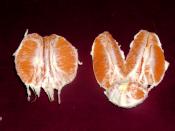"Ode to an Orange" by Larry Woiwode took place in the winter of 1940s. It was "the winters of the forties" which I felt was very important in setting the background. It was a time of war, rationing of food, limited transportation, a difficult time to import items from other states and then adjustment from war of peace. Winter did not just represent cold, snow, wind, gray sky, limited sunshine, but a limiting of the senses. With this in mind it have also been difficult to obtain an orange that would have been harvested in a usually warm place, such as Florida or California. The orange not only became a symbol of a season and the holidays but an object that turned the senses on. From the orange's color, touch of the skin, how it was peeled to the packing of "fresh wood" with the paper labels that contained the image of a "blue goose."
Again the author uses our eyes, sensory impressions, all this to stimulate against the bleakness of "north Dakota winters."
The two young boys are really symbols of heightened imagination and senses in that they see objects, such as an orange, in a very different way than an adult. The children say, "We're getting a cold," instead of saying, "We want an orange." The orange was as precious as a piece of candy and they felt that an excuse must be given to obtain it. The orange again takes on a new role as a role of healing, and relief. The author stirred my memories and experience as a child, which are like these boys' experiences. When I was in Japan, I got a cold many times. Each time I told my mom, "I'm getting a cold," instead of saying, "I want a melon." The...


